 Kawasaki Z1000SX - Service manual > Brake Fluid
Kawasaki Z1000SX - Service manual > Brake Fluid
Brake Fluid Level Inspection
- Refer to the Brake Fluid Level Inspection in the Periodic Maintenance chapter.
Brake Fluid Change
- Refer to the Brake Fluid Change in the Periodic Maintenance chapter.
Brake Line Bleeding
The brake fluid has a very low compression coefficient so that almost all the movement of the brake lever or pedal is transmitted directly to the caliper for braking action. Air, however, is easily compressed. When air enters the brake lines, brake lever or pedal movement will be partially used in compressing the air. This will make the lever or pedal feel spongy, and there will be a loss in braking power.
WARNING Air in the brake lines diminish braking performance and can cause an accident resulting in injury or death. If the brake lever or pedal has a soft or "spongy" feeling mushy when it is applied, there might be air in the brake lines or the brake may be defective. Do not operate the vehicle and service the brake system immediately.
NOTE
- The procedure to bleed the front brake line is as follows.
Bleeding the rear brake line is the same as for the front brake.
- Remove:
Screw [A]
Stopper [B]
Front Brake Reservoir Cap [C]
Diaphragm Plate
Diaphragm - Fill the reservoir with fresh brake fluid to the upper level line in the reservoir.
- Slowly pump the brake lever several times until no air bubbles can be
seen rising up through the fluid from the holes at the bottom of the
reservoir.
- Bleed the air completely from the master cylinder by this operation.
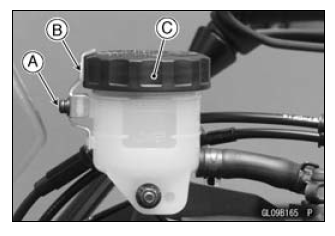
- Remove the rubber cap from the bleed valve on the front master cylinder.
- Attach a clear plastic hose [A] to the bleed valve, and run the other end of the hose into a container.
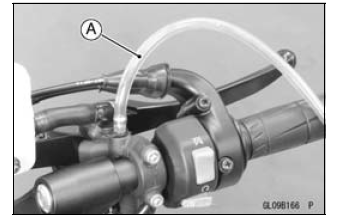
- Bleed the brake line and the master cylinder.
- Repeat this operation until no more air can be seen coming out into the plastic hose.
- Pump the brake lever until it becomes hard, and apply the brake and hold it [A].
- Quickly open and close [B] the bleed valve while holding the brake applied.
- Release the brake [C].
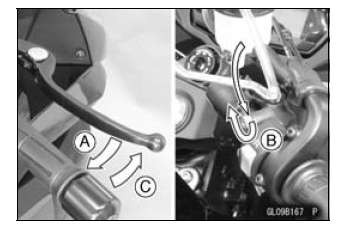
NOTE
- The fluid level must be checked often during the bleeding operation and replenished with fresh brake fluid as necessary. If the fluid in the reservoir runs completely out any time during bleeding, the bleeding operation must be done over again from the beginning since air will have entered the line.
- Remove the clear plastic hose.
- Tighten the bleed valve, and install the rubber cap.
Torque - Front Master Cylinder Bleed Valve: 5.4 N*m (0.55 kgf*m, 48 in*lb)
- Remove the rubber cap [A] from the bleed valve on the caliper.
- Attach a clear plastic hose [B] to the bleed valve, and run the other end of the hose into a container.
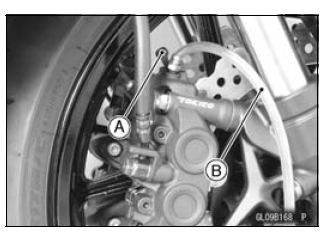
- Bleed the brake line and the caliper.
- Repeat this operation until no more air can be seen coming out into the plastic hose.
- Pump the brake lever until it becomes hard, and apply the brake and hold it [A].
- Quickly open and close [B] the bleed valve while holding the brake applied.
- Release the brake [C].
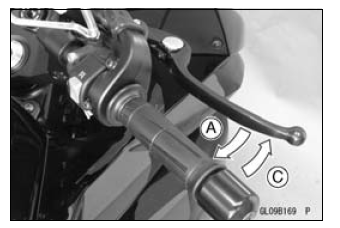
NOTE
- The fluid level must be checked often during the bleeding operation and replenished with fresh brake fluid as necessary. If the fluid in the reservoir runs completely out any time during bleeding, the bleeding operation must be done over again from the beginning since air will have entered the line.
- Tap the brake hose lightly from the caliper to the reservoir for more complete bleeding.
- Front Brake: First bleeding the right caliper then repeat the above steps for the left caliper.
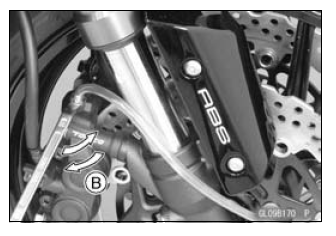
- Remove the clear plastic hose.
- Install:
Diaphragm
Diaphragm Plate
Front Brake Reservoir Cap - Follow the procedure below to install the front/rear brake fluid
reservoir cap correctly.
- First, tighten the brake fluid reservoir cap [B] clockwise [C] by hand until slight resistance is felt indicating that the cap is seated on the reservoir body, then tighten the cap an additional 1/6 turn [D] while holding the brake fluid reservoir body [A].
- Tighten the rear brake reservoir cap stopper screw securely.
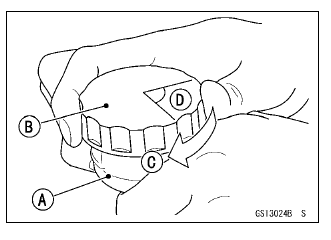
- Tighten:
Torque - Front Master Cylinder Reservoir Cap Stopper Screw: 1.2 N*m (0.12 kgf*m, 11 in*lb) - Tighten the bleed valve, and install the rubber cap.
Torque - Bleed Valves: 7.8 N*m (0.80 kgf*m, 69 in*lb)
- Check the fluid level (see Brake Fluid Level Inspection in the Periodic Maintenance chapter).
- After bleeding is done, check the brake for good braking power, no brake drag, and no fluid leakage.
Brake Hose
WARNING When working with the disc brake, observe the precautions listed below.
1. Never reuse old brake fluid.
2. Do not use fluid from a container that has been left unsealed or that has been open for a long time.
3. Do not mix two types and brands of fluid for use in the brake. This lowers the brake fluid boiling point and could cause the brake to be ineffective. It may also cause the rubber brake parts to deteriorate.
4. Don't leave the reservoir cap off for any length of time to avoid moisture contamination of the fluid.
5. Don't change the fluid in the rain or when a strong wind is blowing.
6. Except for the disc pads and disc, use only disc brake fluid, isopropyl alcohol, or ethyl alcohol for cleaning of the brake parts. Do not use any other fluid for cleaning these parts. Gasoline, engine oil, or any other petroleum distillate will cause deterioration of the rubber parts. Oil spilled on any part will be difficult to wash off completely and will eventually deteriorate the rubber used in the disc brake.
7. When handling the disc pads or disc, be careful that no disc brake fluid or any oil gets on them. Clean off any fluid or oil that inadvertently gets on the pads or disc with a high-flash point solvent. Do not use one which will leave an oily residue. Replace the pads with new ones if they cannot be cleaned satisfactorily.
8. Brake fluid quickly ruins painted surfaces; any spilled fluid should be completely wiped up immediately.
9. If any of the brake line fittings or the bleed valve is opened at any time, the AIR MUST BE BLED FROM THE BRAKE LINE.
Brake Hose Removal/Installation
- Refer to the Brake Hose Replacement in the Periodic Maintenance chapter.
Brake Hose and Pipe Inspection
- Refer to the Brake Hose and Pipe Damage and Installation Condition Inspection in the Periodic Maintenance chapter.
See also:
 Kawasaki Z1000SX - Service manual > Brake Disc
Kawasaki Z1000SX - Service manual > Brake Disc
Brake Disc Removal Remove the wheels (see Front/Rear Wheel Removal in the Wheels/Tires chapter). Unscrew the mounting bolts [A], and take off the disc [B]. Remove the gaskets.
 Rider's Manual BMW R 1250 GS GSA
Rider's Manual BMW R 1250 GS GSA Owner's Manual Harley-Davidson Sportster XL1200X Forty-Eight
Owner's Manual Harley-Davidson Sportster XL1200X Forty-Eight Owner's Manual Honda CBR650R
Owner's Manual Honda CBR650R Service manual Honda CBR650
Service manual Honda CBR650 Owner's Manual Honda PCX125
Owner's Manual Honda PCX125 Owner's Manual Kawasaki Z1000SX
Owner's Manual Kawasaki Z1000SX Service manual Kawasaki Z1000SX
Service manual Kawasaki Z1000SX Owner's Manual Lexmoto Echo
Owner's Manual Lexmoto Echo Owner's Manual Royal Enfield Interceptor 650
Owner's Manual Royal Enfield Interceptor 650 Service manual Royal Enfield Interceptor 650
Service manual Royal Enfield Interceptor 650 Owner's Manual Yamaha MT-07
Owner's Manual Yamaha MT-07